The newly rebuilt runway at St. George Regional Airport (SGU) doesn’t look at all unusual. But its routine appearance belies what’s hidden below: a clever feat of engineering and earthwork designed to stop the pavement heaving that doomed the original runway.
The newly rebuilt runway at St. George Regional Airport (SGU) doesn’t look at all unusual. But its routine appearance belies what’s hidden below: a clever feat of engineering and earthwork designed to stop the pavement heaving that doomed the original runway.
Ironically, the $26 million project that reconstructed the 9,300-foot runway leveraged the same material that caused the runway to start heaving in the first place. The villain and hero was blue clay, which is common in southwestern Utah, where SGU is located.
Airport Manager Rich Stehmeier notes that the pavement issue first arose several years after SGU opened in January 2011. “Some areas on the side of the runway swelled more than 12 inches, which is pretty significant heaving,” says Stehmeier. The culprit was the clay, which expands when it gets wet. Even though crews had removed 5 feet of clay and replaced it with structural fill before building the original runway, later analysis revealed that moisture-filled clay still posed a problem.
|
Project: Runway Reconstruction Location: St. George (UT) Regional Airport 2018 Passenger Volume: 277,000 Project Cost: Approx. $26 million Funding: $13 million FAA grant; $11 million federal infrastructure grant; $2 million airport revenue Construction: May 29–Sept. 25, 2019 Project Engineer: Jviation Inc. Geotechnical Consultants: Landmark Testing & Engineering; Applied Geotechnical Engineering Consultants Inc. Engineering Consultant: Rood & Associates Excavation Contractor: J. P. Excavating Inc. Paving Contractor: Western Rock Products Geomembrane Liner Manufacturer: Axter Coletanche Inc. Electrical Contractor: Tri State Electric & Utility Inc. Public Relations Support: Harmony Public Involvement Key Benefit: Safer, smoother runway Ancillary Projects: Terminal ramp expansion; TSA area renovation; parking lot repair, reseal, restripe Cost: About $700,000 Funding: General airport revenue |
“As water ran off the edges of the runway and down to drainage ditches, some of it still penetrated the ground,” he explains. “Furthermore, as the asphalt got hot during the day, it then pulled moisture under it, where it eventually penetrated into the blue clay below. And when that clay gets wet, it expands like a giant sponge.”
In 2017, engineering consultants from Rood & Associates concluded that the design and construction of the first runway wasn’t to blame. “Their assessment was that the airport was built to—and in some places, better than—the project specifications,” Stehmeier says. “That was an important conclusion, because without it, the FAA wouldn’t pay for fixing the runway.”
In the end, FAA contributed $13 million for the runway reconstruction. A federal grant from a fund created for major infrastructure projects chipped in another $11 million, and revenue from passenger facility charges paid for the balance.
Dirty Work
The airport hired Jviation Inc., an engineering consultant firm, to quarterback the project. With assistance from two geotechnical consultants—Applied Geotechnical Engineering Consultants Inc. and Landmark Testing & Engineering—Jviation developed a runway design to resolve the heaving issue.
The design required crews to excavate 5,400 feet of the existing runway’s footprint to a depth of 17 feet. After that, the excavated clay was “conditioned” on site, and then used to build a 5-foot-thick “plug” to block moisture from penetrating. “It’s similar to the clay liners they build at the bottom of landfills to keep liquids from leaching out,” explains Kirt McDaniel, project manager from Jviation.
Workers conditioned the clay by mixing it with water in large pits until tests showed it had reached optimum moisture content.
On top of the initial layer of clay, crews from J.P. Excavating Inc. installed 12 feet of structural fill that was removed from other sites at the airport. That layer was topped with a geomembrane liner made in the Netherlands by Axter Coletanche Inc.
“It’s the same kind of liner often used on dams to keep water from leaking through,” comments Kevin Scherr, a construction manager at Jviation. “It basically serves as another point that stops water from penetrating down to the native clay below the 17-foot-deep reconstructed area.”
The 3/16-inch-thick, petroleum-based liner was new to the Jviation team. “We’ve never used one like this before,” notes Scherr.
The project required 360,000 square yards of the special liner, which comes in large rolls that weigh more than 1 ton each. Crews used blowtorches to melt the ends together to form one large liner that extends 200 feet from both sides of the 150-foot-wide runway.
To add yet another moisture barrier, the project design called for more than 31,000 linear feet of perforated drainlines on top of the membrane, and then topped that with 6 inches of coarse rock. The drainage system features two main lines that run along each side of the runway, with perpendicular extensions every 500 feet.
“The drainlines help keep water from getting under the runway,” explains Scherr.
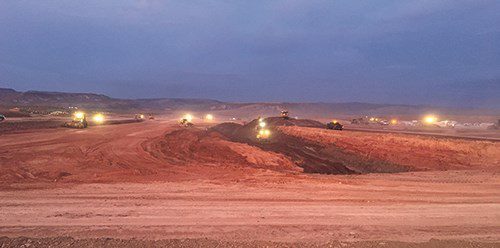
After installing a fabric liner above the layer of coarse rock, crews installed 6 inches of base course followed by 4 inches of asphalt. Western Rock Products performed the paving work.
Excavation Efficiencies
During the course of the project, crews moved a total of 2.45 million cubic yards of material. That included roughly 193,000 cubic yards of conditioned clay—enough to fill nearly 920,000 standard bathtubs, according to Jviation’s estimates.
The project also required 30,660 tons of asphalt; 24,000 linear feet of electrical conduit; 2,300 linear feet of fencing; and 160 cubic yards of concrete.
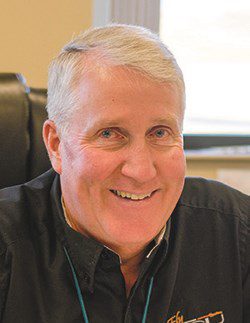 “We were incredibly lucky to get J.P. Excavating as our contractor,” Stehmeier says. “They’re one of the best contractors I’ve ever worked with. Within the first two months, we were two to three weeks ahead of schedule. At that point, we took our foot off the gas pedal a little bit and started working 12-hour shifts instead of 24/7 in order to save some money.
“We were incredibly lucky to get J.P. Excavating as our contractor,” Stehmeier says. “They’re one of the best contractors I’ve ever worked with. Within the first two months, we were two to three weeks ahead of schedule. At that point, we took our foot off the gas pedal a little bit and started working 12-hour shifts instead of 24/7 in order to save some money.
“It was like watching a ballet to see the tractors, dump trucks and huge earthmovers zipping around,” he continues. “You had to keep your head on a swivel if you went out there…but we never had any safety issues.”
The excavating contractor maximized the use of on-site materials to reduce costs for transportation and structural fill. Soil borings revealed 50- to 60-foot-deep deposits of good structural fill on the northwest side of the airport grounds. Using it for the project eliminated multiple 20-mile round trips to pick up and deliver fill material, Stehmeier notes.
Dump trucks hauled “bad” clay from the runway excavation area to the clay-conditioning site, and then carried “good” clay on the way back. “Judd Palmer, who owns J.P. Excavation, thought it all out beforehand,” says Stehmeier. “He had full trucks going both ways. It was incredibly efficient. They worked inside the airport almost the whole time.”
Unconditioned “bad” clay was used to fill a low-lying area north of the runway’s safety zone. The project team estimates that eliminating fees associated with disposing that clay saved the airport $1 million to $2 million.
At any given time, there were seven to nine separate crews working on various aspects of the project. For instance, the team that installed the geomembrane liner worked from about 3 a.m. to 3 p.m., when it became too hot to work with the black liner and blowtorches.
“We also had our two geotech firms monitoring and checking FAA requirements for compaction and clay suitability,” adds Stehmeier. “One firm would do a test, and then the other firm would check their test.”
129-Day Closure
The project team scheduled the runway reconstruction during summer, when local tourism drops due to extreme heat. The airport, which handles about 65,000 operations per year, was closed from May 29 to Sept. 25, 2019.
Management made good use of the downtime by scheduling nearly $700,000 worth of smaller projects during the closure. Crews extended the terminal ramp by 100 feet, remodeled TSA’s section of the terminal and updated the parking lot pavement. General airport revenue was used for those projects. The city of St. George paid for a repaving project at the fuel farm.
“We tried our best to make lemonade out of lemons,” Stehmeier comments. “It’s a horrible thing to have to close down an airport, but it also gave us the opportunity to do some work without inconveniencing our customers.
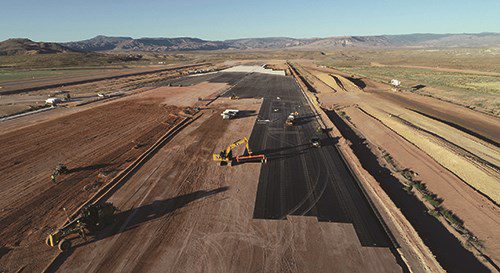
“We also dumped $26 million into the local economy for four months, which is pretty awesome,” he adds. “The only company that wasn’t based locally was the paving contractor, Western Rock; but they run an asphalt plant here.”
On the other hand, SGU lost nearly $500,000 in revenue during the closure. Even so, Stehmeier believes the airport’s 2019 budget may still balance. Before the closure, passenger traffic for the first five months of the year was up 30% compared to 2018.
“So we generated that much more income than expected,” he says. “It would be pretty phenomenal if we even came close to meeting our budget.”
Report as Usual
No airport employees were laid off during the closure. “We actually got stretched pretty thin in terms of staffing,” Stehmeier says. “We were crazy busy.”
Although the runway was closed, airport staff monitored radio traffic 24/7, instead of from 6 a.m. to midnight like usual. “We were worried that people might try to come in at night and land in a big hole,” he explains.
In addition to completing multiple projects during the closure, maintenance crews had to periodically clean construction dust from signs and the helicopter pad, which remained open during the runway work.
Furthermore, two rental car companies remained open, as did several maintenance operators that lease space at the airport. Some stockpiled work, like rebuilding engines or doing annual aircraft maintenance, to stay busy during the shutdown; others leased space at other airports.
Nearby airports including Hurricane Municipal, Cedar City Regional and the privately owned Sky Ranch Airport pitched in during the closure by offering displaced hangar owners free tie-down spots.
“Hurricane rebuilt their airport about four months before us, and we offered their people free tie-downs,” Stehmeier explains. “And Cedar City is redoing their runway in 2020. We work together as a community.”
Getting the Word Out
The airport mounted an intense outreach campaign to spread information about the runway closure as widely as possible. Part of the strategy was hiring a public relations firm, Harmony Public Involvement, which leveraged Facebook and other social media platforms. Despite all that, about 10 pilots still radioed in asking for permission to land.
“There’s always a few that fall through the cracks,” Stehmeier quips.
Aside from that, he says the project couldn’t have run any smoother. Even the weather cooperated. “Aside from one day when it sprinkled a bit, we had no rain, which is so unusual for that time of year it’s not even funny,” he says. “We usually get monsoon-like rain in August and September, so Mother Nature definitely helped.”
“We had a strong team all the way through,” adds Scherr. “It’s always important to have good contractors on board, because you’re dealing with a lot of unknowns. You’re only taking soil bores every couple hundred feet, so once you open things up fully, conditions can change quickly…and you need good contractors who can make adjustments on the fly to build the best possible product.
“Generally speaking, things went pretty much the way we expected, thanks to years of preparation and planning.”

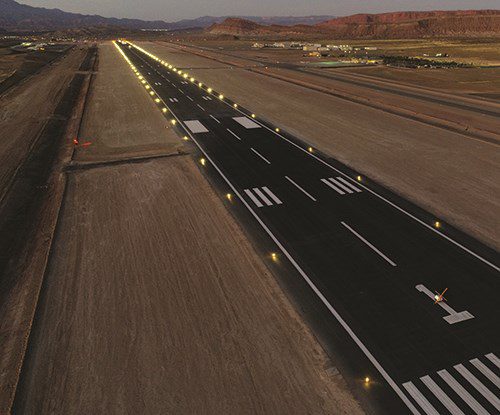
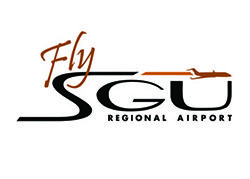 facts&figures
facts&figures

